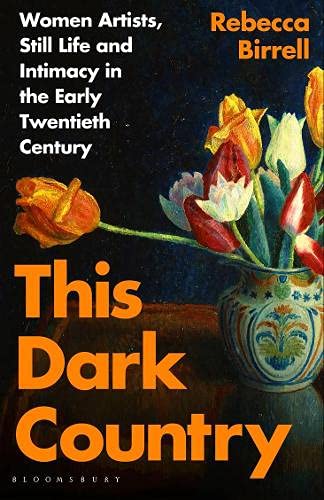This Dark Country: Women Artists, Still Life and Intimacy in the Early Twentieth Century by Rebecca Birrell'A brilliant book ... A truly radical aesthetics fit for the twenty-first century at last!' - Therese Oulton ' [A] wonderful book. I am impressed and fascinated. It is beautifully written' - Celia Paul This book is vital to mark some under estimated artists who where the wrong sex for true success, but make their mark in their own way. One review I found wrote: 'Lemons gleam in a bowl. Flowers fan out softly in a vase. A door swings open in a sparsely furnished room. What is contained in a still life - and what falls out of the frame? For women artists in the early twentieth century, including Ethel Sands, Nina Hamnett, Vanessa Bell and Gwen John, who lived in and around the Bloomsbury Group, this art form was a conduit for their lives, their rebellions, their quiet loves for men and women. Gluck, who challenged the framing of her gender and her art, painted flowers arranged by the woman she loved; Dora Carrington, a Slade School graduate, recorded eggs on a table at Tidmarsh Mill, where she built a richly fulfilling if delicate life with Lytton Strachey. But for every artist we remember, there is one we have forgotten; who leaves only elusive traces; whose art was replaced by being a mother or wife; whose remaining artworks lie dusty in archives or attics. In this boldly original blend of group biography and art criticism, Rebecca Birrell brings these shadowy figures into the light and conducts a dazzling investigation into the structures of intimacy that make - and dismantle - our worlds.' written by Kathryn Hughes for the Guardian WORK FRAMED,
VANISHED, DELIVERED, CURATED, HUNG, CELEBRATED AND NOW DISPLAYING ITS OWN RED DOT I can't tell you how moving the ceremony to mark the opening of the Summer Exhibition at the Royal Academy is. Firstly this ceremony is only for the artist, it was a nerving thing to do to turn up and be celebrated. I arrived at the RA on a Monday in September in time for the traffic to stop as 400 artists walk down Piccadilly to St Jame's church for a celebrating service for Artists. We sang a few hymns, listened to the professional and skilled choir of the church and heard moving lessons from the President of the RA, Rebecca Salter. Hymns sung were: Angle Voices ever singing, Dear Lord and Father of mankind and Immortal, Invisible, God only wise. The choir, who were much more skilful than us artists, sang beautifully; William Byrd (c1540-1623) O quad glorious and Herbert Howells (1892 - 1983) Like as the hart desireth the water brooks. I was immensely moved by the history that the church represents and the honouring of artists, an often self-forgotten profession. After the service, another traffic stopping walk back to the Burlington entrance to the RA and after a short dance session to the steel band, I entered the show. The place is spattered with faces I know but then realising I don't know them at all as they are either famous actors or artists! I went to find my painting first, an exciting adventure to distract me from the over whelmness. The Summer Exhibition comes with its own A5 catalogue with all the artworks and their artists listed, I found my painting listed as 1111, in room IX, which had been curated by Vanessa Jackson RA and Evaa Rothschild RA. I found chatting to other artists a real pleasure and stayed right until the end where a friend and I played dressing up with tiaras. A story that is priceless but to be told another time. W O R K
F R A M E D V A N I S H E D D E L I V E R E D and A C C E P T E D I have been accepted to show one of my pieces in this years Royal Academy Summer Exhibition. The Summer Exhibition has been going over 250 years, the open exhibition has been filling the main galleries at Burlington Arcade every year since 1769. Each year an artist is invited to set the show, this 2021 Yinka Shonibare is the chosen artist and him and a panel of artists, are working under the theme of ‘Reclaiming Magic' and celebrating the joy of creating art. The show is around 1000 pieces of print, painting, photography and film, as well as sculpture, architectural works. My piece is a 2-dimensional oil painting which I painted in situ last July, the summer 2020 lockdown. Every artist talks about a dialogue between themselves and their canvas and I had not noticed this kind of relationship with my canvases when I painted until I painted this one. It is called 'What Would Happen If I wasn't Here?' and is part of a series looking at identity. What it is to be a woman, a mother, a sister, a daughter, a homeowner, and home-maker. What do these titles mean and how they manifest themselves in our lives. I have a few from this series and I will put them into an on-line exhibition on my website. I am so bloody pleased. love from today when all the hard work with sweat and a few tears feel worth it. Victoria |
AuthorI am a professional painting artist, with a passion for space, shadow, colour and balance - constantly pushing forward to express more of what I see and feel visually. Archives
June 2024
Categories
All
|
V i c t o r i a A l b u q u e r q u e A r t
|
W h a t o t h e r s s a y
|
|
Contact me via my mobile on 07900 117525
via e-mail on [email protected] studio address West Street Farm Studios Gun Hill Heathfield TN21 0LA East Sussex Shipping Returns policy Format Private Policy |
“I love the intensity and depth of Victoria’s work”. Phillippa Craddock - critically acclaimed florist, celebrated for her appointment to the Royal Family, helping celebrate the wedding of Harry and Megan.
|
“the tenderness in Victoria’s paintings – they make me want to stay with them and become part of them. They are intensely intimate and heartbreaking beautiful.”
Elizabeth Roberts - Editor, Black+White Photography Magazine. |






 RSS Feed
RSS Feed